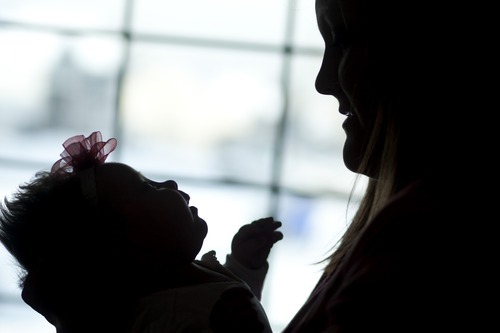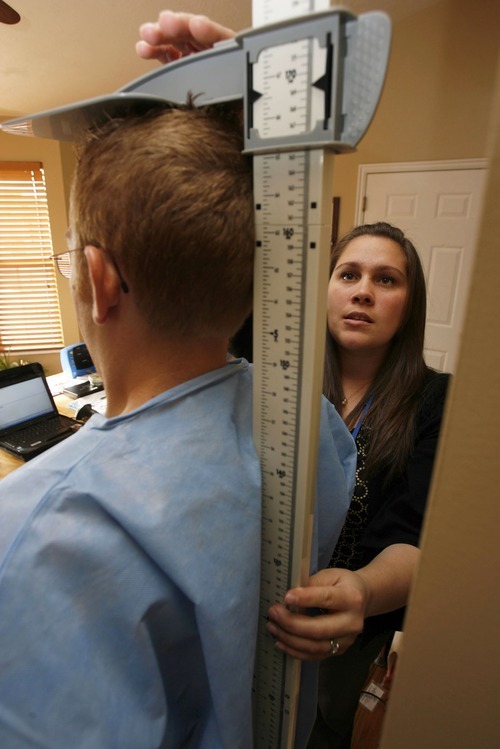This is an archived article that was published on sltrib.com in 2012, and information in the article may be outdated. It is provided only for personal research purposes and may not be reprinted.
As Ed Clark makes his hospital rounds, checking in on children who need ventilators for their asthma or on the premature babies in intensive care, or as he sees obese children in neighborhoods waiting to ride a school bus, the state's top pediatrician has no doubt of the need of the National Children's Study, a massive effort to track the health of 100,000 children from womb to age 21.
Clark, chief medical officer of Primary Children's Medical Center, retains his trust in the effort even though his hospital recently learned it will no longer be involved in collecting data and that the study has shifted goals — making it less scientifically rigorous, according to some.
"What I have heard at every level of the organization is the children's study will proceed," Clark said this week. "We desperately need this study as part of an overall program to understand the root cases of diabetes, obesity, autism, asthma, prematurity."
Salt Lake County was one of seven "vanguard" sites to pilot the largest study to evaluate the effects of the environment, genetics and social factors on children's health. The goal is to understand — and eventually prevent — factors that lead to the diseases now facing children.
It was anticipated that the academic and community-based pilot sites would continue to collect data and recruit women as the study continued.
But all seven locations recently learned their contracts — the University of Utah's started in 2005 — will not be extended after May. Instead, a North Carolina company, Research Triangle Institute, will take over data collection.
Clark estimated that up to 20 people will lose their posts, though he believed the University of Utah's pediatrics department, of which he is the chairman, will be able to find jobs for them. And the university will lose about $2.5 million a year, he said. The U., which is working with staff at Primary Children's on the study, has earned about $20 million for the work since 2005, he said.
It's apparently part of a cost-cutting measure. As first reported by the journal Nature, the White House has proposed to cut the study budget by 15 percent, or $28 million, next year, down to $165 million.
Managed by the National Institute of Child Health and Human Development (NICHD), the study was authorized in 2000, and the pilot phase launched in 2009. But according to Nature, just 4,000 subjects have enrolled during the pilot even as $30 million was spent on recruitment in 2011.
Salt Lake County has been one of the top recruitment sites, Clark said.
The study's main launch has been delayed from 2013 to early 2014, Clark said. Recruitment has been on hold.
The U. expects to send letters alerting the roughly 400 Salt Lake County women who have participated so far, assuring them the data collection company is well respected and that their confidentiality will be maintained. Home visits are also planned.
The women can choose to stay in the study. They have invited researchers into their homes to collect air, dust, blood and urine samples. Mothers have submitted pages of information about the foods they eat, their exposure to pesticides and pets and their parenting practices.
Researchers have attended many of the 300 or so births to collect blood samples from the placenta and umbilical cord and the babies' first stool. The study is "ramping up" as the first child participants turn 3.
Clark also wants to assure families that Primary Children's and the U. will maintain data from the local participants so that Utah-specific research can occur.
"We have an ongoing commitment to our community, to our families," he said. "It's very important we have local eyes on what's going on here."
Due to the study's budget problems, recruiters will no longer go door-to-door seeking pregnant women or women who plan to become pregnant — as was done in Salt Lake County. NICHD wants to save money by recruiting women at provider offices.
Changing from that gold standard of sampling has angered some in the scientific community. Two scientists on the study's advisory committee have resigned in protest; one said the new strategy won't yield data that is representative of the nation, according to Nature and Science journals.
NICHD said in a statement that the change can recruit women more quickly for less money, particularly if HMOs help the effort. But it acknowledged some providers may not join, and the tactic excludes uninsured women.
The study's leadership is considering how to implement the switch while reaching out to underserved women.
The White House budget document admits the change will reduce "precision in describing prevalence rates and generalizing some of the relationships observed." But door-to-door recruiting requires too much money and time, it said.
Primary Children's and the U. helped study different methods when the pilot extended to Cache County in 2010. Some 800 women there have been recruited through mailers.
Clark said the study will "still be valuable. … Science is evolving. Our understanding is evolving."
And the U.'s role may change, too. Clark said the U. has secured other study contracts to evaluate ways to collect placenta samples and to uniformly describe physical features of children. He anticipates it will seek and secure other opportunities for contracts as the study progresses.
Unraveling the mysteries of children's health
Forty-three states now have National Children's Study locations. In 2005, Utah was among the states that had the first seven vanguard centers. The first study areas were:
Duplin County, North Carolina
Montgomery County, Pennsylvania
New York City (Queens), New York
Orange County, California
Salt Lake County, Utah
Waukesha County, Wisconsin
Combined site: Brookings County, South Dakota, and Lincoln, Pipestone, and Yellow Medicine Counties, Minnesota







